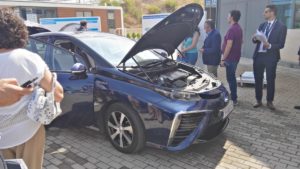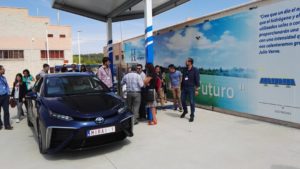Cars of the future and the past use hydrogen

Toyota FCV Plus VS GM Electrovan:
Cars of the future and the past equipped with a hydrogen battery go hand in hand in this article dedicated to these two vehicles.
Many people think that the first hydrogen fuel cell powered vehicle was GM Electrovan, but it is not, the story goes back to the nineteenth century.
In 1959 Harry Ihrig introduced a fuel cell composed of 1,008 cells with 15 kW capacity, associated with an engine that can move an Allis-Chalmers agricultural tractor.

Tractor with hydrogen battery.
Hydrogen gas to feed the cell was obtained from propane gas (C₈H₈), although the carbon that is released by generating the hydrogen messes up the electrolyte.
50 years since GM Electrovan:
In 1966 General Motors presented this visionary electric van based on the GMC Handivan. Inside it had two gas tanks one of liquid hydrogen and another of liquid oxygen that combined to generate the electricity that fed its batteries.
The project managers Electrovan worked tirelessly, three shifts for months. It was a team made up of 250 people led by General Motors’ chief of engineering projects, Craig Marks.
The result of the work was a van that weighed 3,220 kg with a stack of 32 modules and a continuous power of 32 kW, with a maximum of 160 kW. The stack was accompanied by deposits of hydrogen, oxygen and potassium hydroxide which used as electrolyte plus nearly 170 meters of tubes.
The Electrovan achieved a top speed of 100 kilometers per hour, and had an autonomy of less than 200 kilometers, but sacrificed all its cargo space and only allows space for two passengers in the cabin.
General Motors continued to research the fuel cell with the HydroGen, HyWire, Sequel and Equinox projects, so it was the manufacturer that introduced more fuel cell patents between 2002 and 2012.
It continues to investigate in collaboration with the United States Army through the Chevrolet Colorado ZH2.
Toyota FCV Plus: The new power plant:
In about 12 years we will be able to see the Toyota FCV Plus (“the car of the future”) is a hydrogen-powered vehicle that has also been designed to be its own energy source.
The three basic functions of this car are: guarantee mobility, share energy and support future electricity generation.
You can use hydrogen from an external source (an auxiliary tank) to generate electricity, not necessarily to drive, without having to spend from the fuel tank.
Another interesting option is that you can remove the fuel cell from between the front wheels, and use it as a portable generator. In addition to loading other vehicles there are wireless load panels on the rear wheels and under the front floor.
It strikes me that you have been able to reduce the size of the fuel cell and other components. The Toyota FCV Plus has very compact dimensions (3,800 mm in length), perfect for the city. Also incorporates in the windshield and the rear moon a series of symbols announce the state in which the car is during the parking.
Toyota hopes to produce 30,000 car fuel cell or hydrogen engine over the next few years encouraging figures for this sector.
Where will this hydrogen get?
The origin of H2 is very important because currently 80% of the energy system is of fossil origin and therefore polluting.
If we create electric cars, electricity demand will Increases very fast and much of that electricity will be 80% polluting.
It is necessary to create an energy system based on renewable sources that do not contaminate and that are stable.
As a Chemical Engineer specializing in hydrogen, I have set out to develop ideas based on technology that help create a new and better energy system for all.

























